Imagine being told you were going to make a Ghost Mask in Thailand. What vivid, mysterious images come to mind? For many, the idea conjures up notions of eerie spirits or ancient rituals. Yet, the reality of Thailand’s Phi Ta Khon festival and its iconic masks is far more vibrant, whimsical, and deeply rooted in a rich cultural tapestry.
My own journey into this fascinating world began with a mix of curiosity and slight trepidation. We were en route to the Phi Ta Khon Museum, tasked with painting one of these enigmatic “ghost masks.” As our van navigated the winding roads of Loei province, a quiet buzz filled the air. We exchanged wondering glances, each of us trying to conjure an image of what a Thai ghost mask truly entailed.
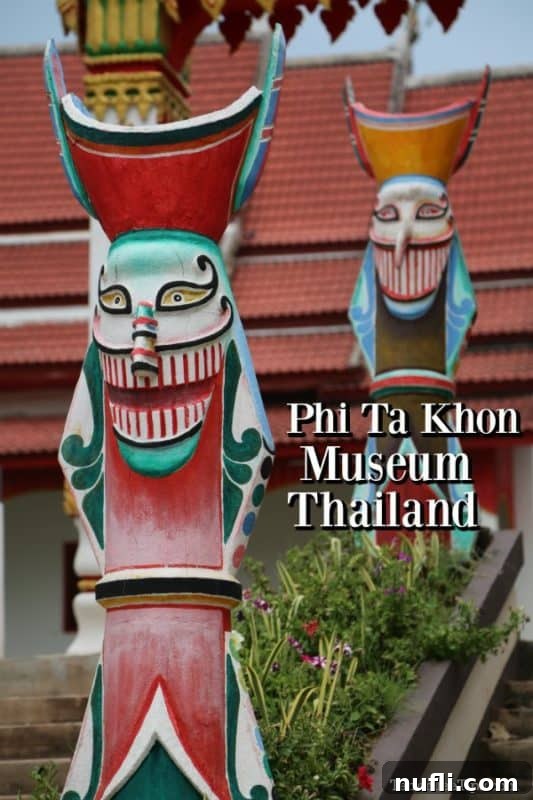
Thankfully, our knowledgeable guide provided some initial clues, pointing out several statues of the distinctive ghost masks along the roadside. The initial mystery began to unravel, replaced by a fresh wave of apprehension. These weren’t the fearsome, somber masks I might have imagined. Instead, they were incredibly intricate, wildly colorful, and undeniably artistic. My heart sank slightly; my own painting skills, I must admit, tend to hover somewhere around the pre-school level. Despite my grandmother being a talented painter, her artistic genes, regrettably, skipped a generation.
An Artistic Journey at the Phi Ta Khon Museum in Dan Sai
Stepping into the Phi Ta Khon Museum, located in the heart of Dan Sai, Loei Province, felt like entering a portal to a world brimming with cultural narratives and artistic expression. The museum serves as an invaluable custodian of the Phi Ta Khon festival’s legacy, offering an immersive journey into its history, traditions, and the incredible craftsmanship behind its celebrated masks. It’s more than just a collection of artifacts; it’s a living testament to a unique Thai Buddhist celebration.
The exhibits beautifully explained the origins of the Phi Ta Khon, shedding light on its deep connections to Buddhist beliefs and ancestral spirits. The festival, often referred to as the “Ghost Festival,” is intricately linked to the Vessantara Jataka, a traditional Buddhist tale recounting the penultimate life of the Buddha. The story tells of Prince Vessantara’s return to his city after a long exile, an event so joyous that it was believed to have roused spirits and ghosts to join the celebration. This narrative forms the whimsical foundation of Phi Ta Khon, transforming what might sound eerie into a vibrant, joyous, and sometimes boisterous display of community spirit.
The museum showcases a dazzling array of Phi Ta Khon masks, each a unique masterpiece. These aren’t mass-produced items; they are traditionally crafted from natural materials like woven bamboo, dried sticky rice husks, and coconut leaves, often adorned with wood carvings for features like the elongated, phallic noses that are characteristic of the masks. Each mask is then meticulously painted with an explosion of bold colors and imaginative patterns, giving them distinctive, often mischievous, expressions. Seeing them up close, you appreciate the sheer ingenuity and artistic dedication involved in their creation. From the comical bulging eyes to the wide, grinning mouths, every detail contributes to the masks’ undeniable charm and their role in bringing the spirits of the ancestors to life in a benevolent and celebratory manner.
My Personal Encounter with a Phi Ta Khon Mask
After absorbing the rich history and artistry, it was our turn to try our hand at mask painting. Presented with a plain, white Phi Ta Khon mask, my earlier apprehension returned. The intricate details I had admired in the museum’s displays felt daunting. Faced with a blank canvas and my limited artistic prowess, my strategy quickly devolved into embracing bold colors and big, sweeping lines. Fine details and delicate brushstrokes were definitely not going to be my strong suit that day!
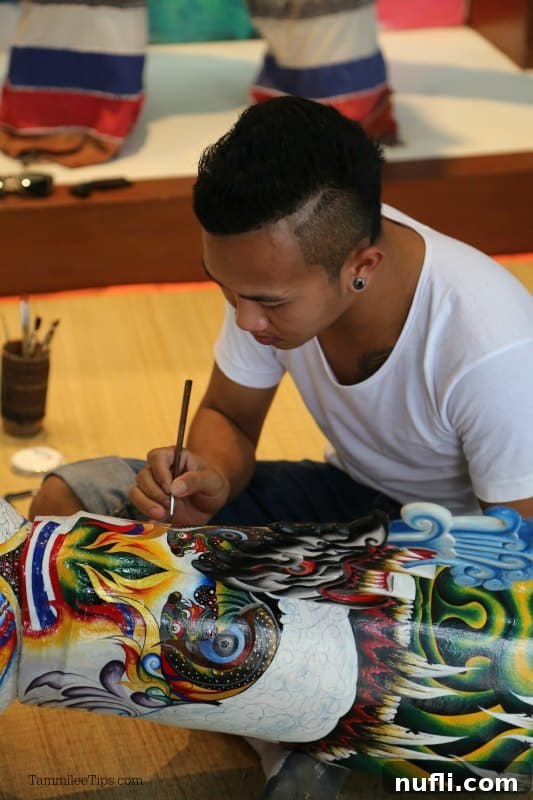
Despite my self-professed lack of talent, I must confess, the experience was incredibly enjoyable. There’s something wonderfully liberating about letting go of perfection and simply immersing yourself in a creative process. It was a fantastic bonding adventure for our group of writers. We found ourselves sprawled across a polished wood floor, the Thai humidity a constant companion, the air thick with the scent of paint and shared laughter. In a room without air conditioning, the warmth and moisture were palpable, yet it only added to the unique, immersive atmosphere. We giggled at our artistic attempts, complimented each other’s unique styles, and collectively reveled in the joy of creating something truly our own.
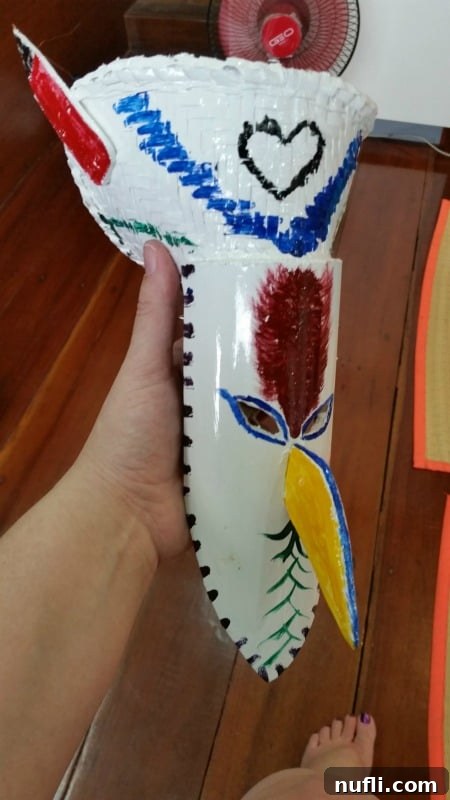
While we fumbled with our brushes, we had the privilege of observing a true master painter at work. His nimble fingers and focused gaze created breathtakingly intricate patterns on a mask with effortless grace. It was a humbling reminder of the dedication and skill that goes into traditional craftsmanship. The sheer number of hours involved in transforming raw materials into such vibrant, expressive works of art was truly astonishing. Watching him, I gained an even deeper appreciation for the cultural significance and artistic heritage embodied in each Phi Ta Khon mask. It wasn’t just paint on bamboo; it was history, spirituality, and community brought to life.
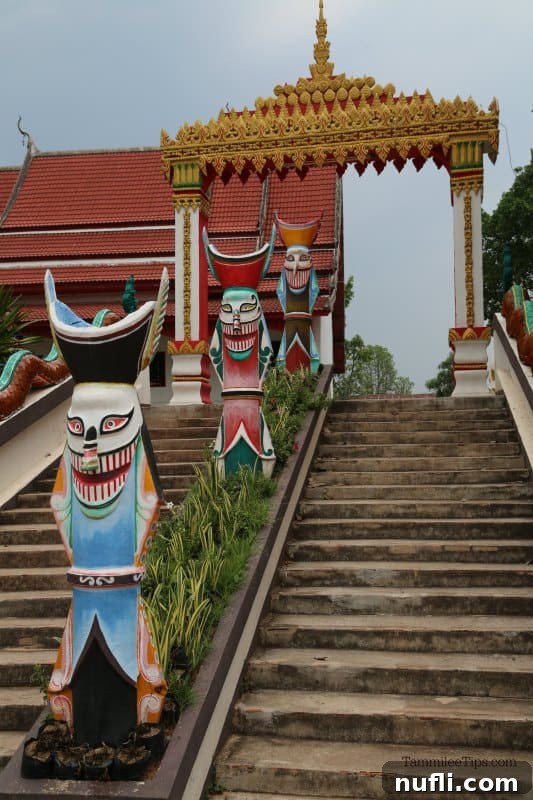
The Vibrant Spectacle of the Phi Ta Khon Festival
The Phi Ta Khon festival itself, also known as Bun Luang, is a spectacular annual event primarily held in the districts of Amphoe Dan Sai and Amphoe Na Haeo in Loei Province. Unlike fixed-date festivals, its timing is determined by the local mediums, usually falling on a Friday, Saturday, and Sunday between March and July, corresponding with the sixth full moon of the lunar calendar.
This three-day celebration is a magnificent fusion of animist and Buddhist traditions, creating an atmosphere unlike any other festival in Thailand. The core belief behind Phi Ta Khon centers around the connection between Buddhism and the spirits of ancestors, who are invoked and celebrated. It’s a joyful reunion, a time when the living and the spirit world are believed to mingle in a festive revelry.
The first day of the festival traditionally kicks off with the auspicious Phra Upakhut procession. Monks, local officials, and villagers walk from the Man River to Wat Phon Chai, carrying a revered Buddha image. This ceremony is believed to bring blessings and protect the festival from rain. As the procession moves through the town, the air fills with the vibrant sounds of traditional music, firecrackers, and the joyous shouts of participants.
The second day is the true highlight, bursting with energy as the Phi Ta Khon participants—mostly young men—don their elaborate masks and colorful, often patchwork, costumes. They parade through the town, dancing, interacting with the crowd, and playfully ‘scaring’ onlookers with their grotesque yet endearing masks. The masks, made from carved coconut tree trunks or steamed sticky rice husks, are distinctive for their long, pointed noses and sometimes phallic symbols, adding to the festival’s playful and fertility-focused undertones. The costumes often feature bells and rattles, announcing the approach of the “ghosts.” This day is a riot of color, sound, and laughter, a truly unforgettable cultural immersion.
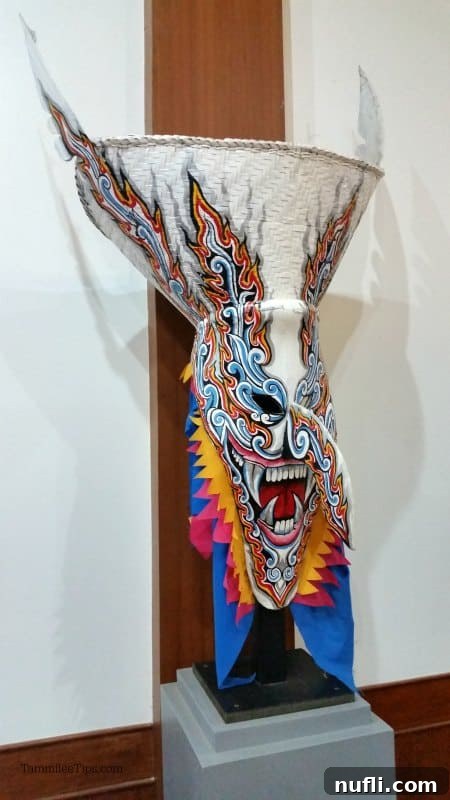
A crucial ritual on the second day involves the Phi Ta Khon participants symbolically casting their costumes and accessories into the Man River. This act signifies the release of sins and bad luck, cleansing themselves and the community before the more solemn Buddhist ceremonies begin. It’s a powerful symbolic gesture that underscores the festival’s spiritual depth beneath its playful facade.
Throughout the event, a series of all 13 chapters of the Great Birth Sermon (Phra Vessantara Chadok) is recited by monks, reinforcing the Buddhist teachings and moral lessons associated with the festival. This intertwining of boisterous celebration and profound spiritual reflection is what makes Phi Ta Khon such a uniquely captivating cultural experience.

Planning Your Visit to Loei Province and the Phi Ta Khon Festival
A visit to the Phi Ta Khon Museum and, if timing permits, the festival itself, offers an unparalleled opportunity to delve into the heart of Thai culture beyond the bustling cities and well-trodden tourist paths. Loei Province, with its serene mountainous landscapes and rich traditions, provides a tranquil yet culturally stimulating escape.
While the festival dates vary, keeping an eye on official tourism announcements is crucial if you wish to witness the full spectacle. Even outside of festival season, the museum provides an excellent window into this vibrant tradition. It’s easily accessible from Loei city and offers a fascinating day trip for anyone interested in authentic Thai heritage.
Whether you’re an art enthusiast, a history buff, or simply a curious traveler seeking unique experiences, the Phi Ta Khon Museum and the captivating story of its ghost masks offer a journey into the spiritual and artistic soul of Thailand. My personal experience of painting a mask, despite its amateur outcome, forged a memorable connection to this extraordinary culture. It’s an adventure that promises laughter, learning, and a deeper appreciation for the beautiful diversity of Thai traditions.
Essential Resources for Your Thailand Adventure
Ready to plan your trip to Thailand? Here are some quick links to help you find the best accommodations and tours for an unforgettable experience:
Find Your Perfect Stay:
🏨Hotels and Vacation Rentals Across Thailand
Discover Unforgettable Experiences:
📍Tours and Activities in Thailand
Further Thailand Travel Guides
Delve deeper into Thailand’s wonders with our other detailed guides:
- Discover Wat Pho: Home of the Reclining Buddha in Bangkok
- Explore Wat Arun, the Temple of Dawn in Bangkok
- Experience Luxury at W Koh Samui
- A Journey to the Thai Dam Cultural Village near Loei
- A Whimsical Photo Tour of the Hello Kitty Hotel in Phu Rua
Check out all of our Comprehensive Thailand Travel Guides for more inspiration and planning tips.
